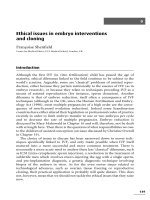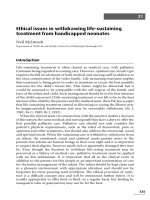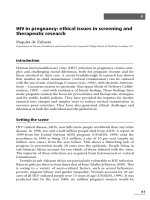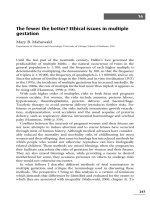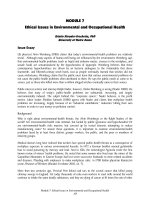Ethical Issues in Pharmacogenomics
Bạn đang xem bản rút gọn của tài liệu. Xem và tải ngay bản đầy đủ của tài liệu tại đây (3.24 MB, 52 trang )
ETHICAL ISSUES IN
PHARMACOGENOMICS
Mark A. Rothstein, J.D.
Herbert F. Boehl Chair of Law and Medicine
Director, Institute for Bioethics, Health Policy and Law
University of Louisville School of Medicine
© April 2009
WHY PHARMACOGENOMICS?
SAFETY
EFFICACY
ADVERSE EVENTS
FROM MEDICATIONS
• Annual deaths due to medical errors, 40-100K
mostly adverse drug reactions
(4th-6th leading cause of death)
• Annual cost of drug-related
problems in ambulatory care
$200B
• Percentage of in-patients
with serious adverse drug reactions
6.7%
• Percentage of in-patients
with fatal drug reactions
0.3%
SELECTED MEDICATION EFFICACY RATES
FOR COMMON CONDITIONS
Condition
Efficacy Rate (%)
Analgesics (Cox2)
80
Depression (SSRI)
62
Asthma
60
Cardiac arrythmias
60
Diabetes
57
SELECTED MEDICATION EFFICACY RATES
FOR COMMON CONDITIONS
Condition
Efficacy Rate (%)
Migraine (acute)
52
Migraine (prophylaxis)
50
HCV
47
Incontinence
40
Alzheimer's
30
Oncology
25
Source: Manasco & Arledge (2003)
The Promises of
Pharmacogenomics
More effective medications
Fewer side effects
Faster and cheaper clinical trials
“Rescue” drugs
DRUG
DEVELOPMENT
10-15 years
Up to $800,000,000 each
PROFESSIONAL
RESPONSIBILITIES
Physicians, Nurses, and Pharmacists
• Order genetic testing
• Interpret tests
• Provide counseling
MANUFACTURER
RESPONSIBILITIES
Research and development
Clinical trials
Warnings
Marketing
1. WARNINGS
Cassidy v. SmithKline Beecham
(C.P. Chester County, Pa., filed December 1999)
Class action lawsuit alleging that manufacturer
of vaccine for Lyme disease (Lymerix) failed to
warn that some individuals, based on their
genotype (HLA-DR4+), would be susceptible
to “treatment-resistant Lyme arthritis.”
How is the manufacturer supposed to provide
warnings to the consumer?
Are product labels, package inserts, or other
types of warnings sufficient?
Is there a danger in having
too many warnings?
2. LEARNED INTERMEDIARY
Can a manufacturer reasonably rely on the
prescribing physician or dispensing
pharmacist to supply warnings?
How “learned” are the intermediaries?
If it is foreseeable that the intermediaries
lack the needed expertise, then the
manufacturers may not be able to escape
liability.
3. DIRECT TO CONSUMER ADVERTISING
DTC advertising began in 1997 pursuant to an
FDA guidance. It has now grown to $4-5 billion
per year.
It must be assumed that there would be DTC
advertising of pharmacogenomically-based
products.
Possible effects on liability: negligent marketing.
4. OFF-LABEL USES
The FDA regulates drugs
and devices; it does not
regulate the practice of
medicine. A physician is
permitted to prescribe a
drug for any use that, in the
exercise of reasonable
medical judgment, is
appropriate.
If a physician prescribes a drug approved
for patients with a different genotype, is
the manufacturer liable for adverse
events?
It may depend on whether the off-label uses
were reasonably foreseeable, whether the
manufacturer failed to act against potentially
harmful off-label uses, and whether the
manufacturer encouraged off-label uses, such
as through advertising or publications.
5. POST-MARKETING SURVEILLANCE
If drugs are marketed based on smaller,
genotype-matched trials, new responsibilities
may be placed on manufacturers to undertake
more vigilant post-marketing surveillance.
In theory, this should be easier to do with the
widespread adoption of electronic health
records and networks.
The failure to do adequate post-marketing
surveillance might be another basis of liability.
WARFARIN
• Blood thinner is prescribed more than
30M times each year.
• It accounts for 43M ED visits each year
(second only to insulin).
• People with a variant of the genes
CYP2C9 or VKORC1 (vitamin K epoxide
reductase) break down the drug more
slowly, which means that it stays in the
body longer and causes bleeding.
• In 2007, the FDA announced that a new
label is being required for Warfarin, which
states, under "precautions": Certain
variations in two key genes may increase
the need for more frequent monitoring and
the use of lower doses.
• FDA projects that
widespread use of
genetic testing as
part of prescribing
could avoid 85,000
serious bleeding
events and 17,000
strokes, saving about
$1.1B annually.
Woodcock J. and Lesko L. N Engl J Med 2009;360:811-813.
• The genetic test costs $300-$500.
• Turnaround time for tests can be as
much as 10 days.
• On May 4, 2009, CMS announced it will
not pay for the tests because of a lack
of evidence of clinical utility.
Ethical Issues
Example: Selecting Drug Targets
Before spending tens or hundreds of
millions of dollars on a new drug for a
particular allele, any biotech or
pharmaceutical executive would want to
know the allele frequency as well as the
demographic characteristics of the
population with the allele.

